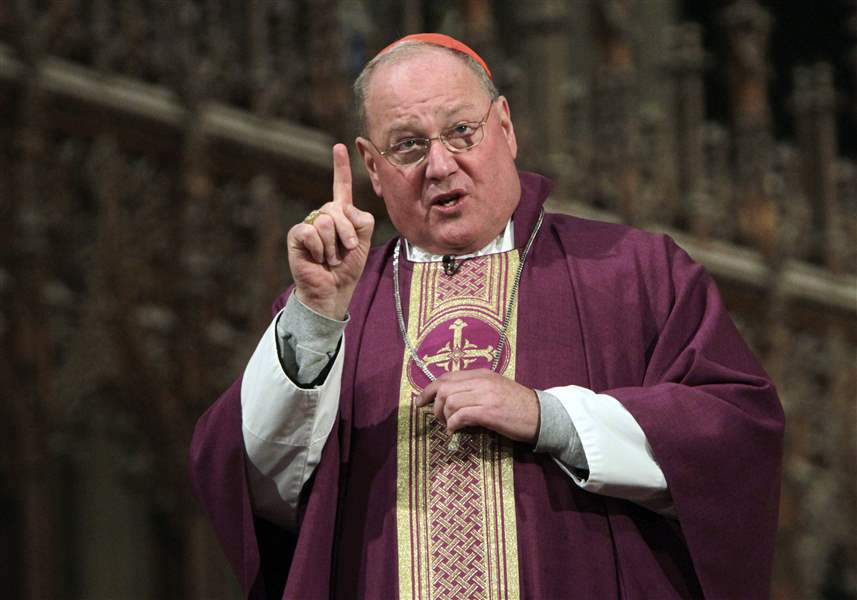
Archdiocese documents show Dolan asked to transfer $57M to trust before Milwaukee bankruptcy
7/1/2013
The Archdiocese of Milwaukee released thousands of pages of documents related to clergy sex abuse which church officials say include the depositions of New York Cardinal Timothy Dolan, seen here in February, 2012, the former archbishop of Milwaukee.
ASSOCIATED PRESS

The Archdiocese of Milwaukee released thousands of pages of documents related to clergy sex abuse which church officials say include the depositions of New York Cardinal Timothy Dolan, seen here in February, 2012, the former archbishop of Milwaukee.
MILWAUKEE — Former Milwaukee Archbishop Timothy Dolan sought and received permission from the Vatican to move $57 million from a cemetery fund into a trust to provide “improved protection” as the archdiocese prepared to file for bankruptcy amid dozens of claims by victims of clergy sex abuse, according to documents made public today.
Dolan’s 2007 letter, which he wrote while serving as archbishop in Milwaukee, and the Vatican’s response were included in thousands of pages of documents the archdiocese released as part of a deal reached in federal bankruptcy court between the archdiocese and clergy sex abuse victims suing it for fraud. Victims say the archdiocese transferred problem priests to new churches without warning parishioners and covered up priests’ crimes for decades.
The victims’ attorneys have accused Dolan, who currently is the cardinal of the Archdiocese of New York, of trying to hide the money as the Milwaukee archdiocese planned for bankruptcy. The archdiocese denies those allegations.
In a statement released today, Dolan called any suggestion he was trying to shield money from victims an “old and discredited” attack. Jerry Topczewski, chief of staff for current Archbishop Jerome Listecki, said the money was always set aside in a separate fund for cemetery care and moving it to a trust just formalized that.
The release of about 6,000 pages of documents has drawn national attention because of the involvement of Dolan, who is president of the U.S. Conference of Catholic Bishops and the nation’s most prominent Roman Catholic official. Dolan, who has not been accused of transferring problem priests, took over as archbishop in mid-2002 after many victims had already come forward. But there have been questions about his response to the crisis.
In his June 4, 2007, letter to the Vatican, Dolan said the cemetery fund money would still have to be used to care for cemeteries if placed in a trust. But, he added: “By transferring these assets to the Trust, I foresee an improved protection of these funds from any legal claim and liability.”
Other documents released today provide new details on payments made to abusive priests when they left the church during Dolan’s tenure.
The archdiocese has characterized the money, as much as $20,000 in some cases, as a kind of severance pay meant to help priests transition out of the ministry. Similar amounts were made to men leaving the priesthood long before allegations of sexual abuse surfaced in the Catholic church, spokeswoman Julie Wolf said last year, when the payments came to light.
The documents also include the depositions of Dolan and his predecessor, Archbishop Rembert Weakland, along with the personnel files of 42 of the 45 archdiocese priests with verified abuse claims against them. Allegations against one priest came to light only after the archdiocese filed for bankruptcy and his file will be released later, once it is complete, Topczewski has said. Two other priests’ files aren’t being released because they involve single victims who could easily be identified.
Clergy sex abuse victims have criticized the archdiocese for releasing only part of the priests’ files. The documents made public represent about 10 percent of what was turned over to victims’ attorneys during litigation. Attorneys for both sides agreed on which ones would be posted. Along with the actual documents, the archdiocese published a narrative about each priest and a timeline of his career.
Archbishop Jerome Listecki said last week in an email to priests, parish leaders and others that the reports of abuse go back as much as 80 years. In the 1970s and 80s, priests were often removed from their parishes, sent for counseling and then reassigned. Twenty-two Milwaukee priests were reassigned to parish work after allegations of abuse and eight offended again, he said. Overall, Listecki said, “people were ill-equipped to respond” to the problem.
Similar files made public by other Roman Catholic dioceses and religious orders have detailed how leaders tried to protect the church by shielding priests and not reporting child sex abuse to authorities. The cover-up extended to the top of the Catholic hierarchy. Correspondence obtained by The Associated Press in 2010 showed the future Pope Benedict XVI had resisted pleas in the 1980s to defrock a California priest with a record of molesting children. Cardinal Joseph Ratzinger led the Vatican office responsible for disciplining abusive priests before his election as pope.
Abuse victims have long sought to hold the church accountable, but most didn’t come forward until well into adulthood, when it was too late under Wisconsin law to sue the church for negligence in supervising its priests. A 2007 Wisconsin Supreme Court decision gave them a window, saying the six-year limit in fraud cases didn’t start until the deception was uncovered. The archdiocese filed for bankruptcy in 2011, once it became clear that it was likely to face a slew of lawsuits.
As of June 30, 2012, the archdiocese had spent nearly $30.5 million on litigation, therapy and assistance for victims and other costs related to clergy sex abuse, according to its annual statement. It faces sex abuse claims from about 570 people in bankruptcy court, although some of them involve lay people or priests assigned to religious orders, not the archdiocese.